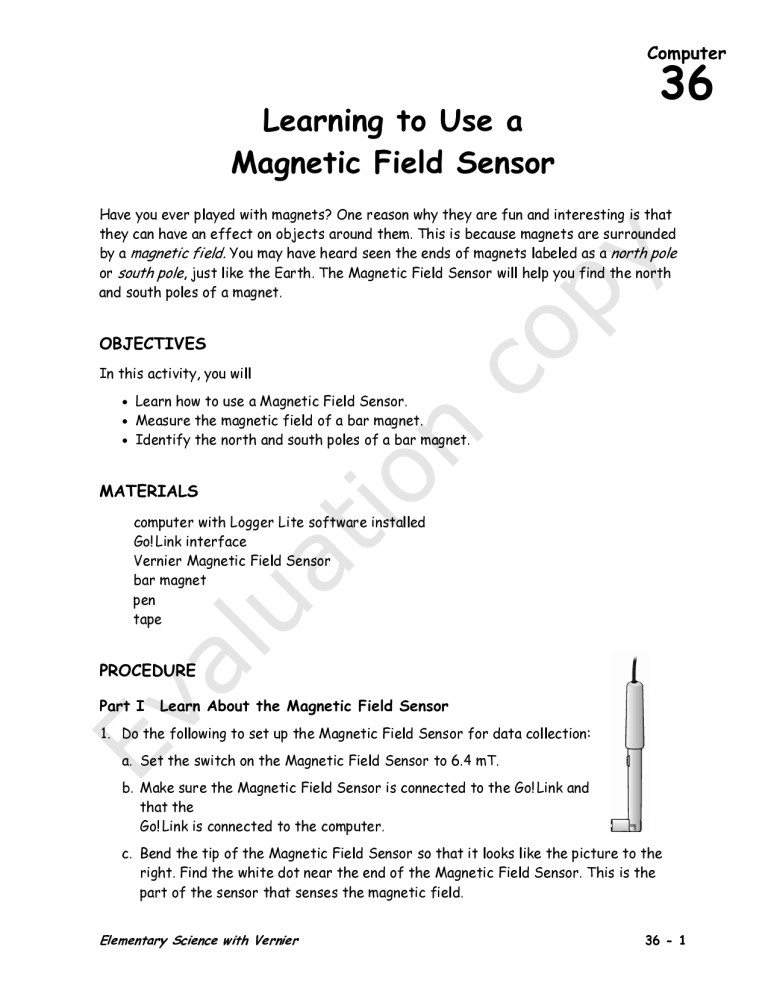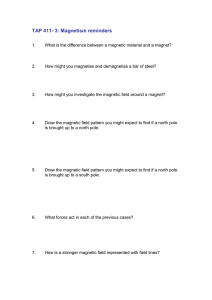Learning to Use a Magnetic Field Sensor

Computer
36
Learning to Use a
Magnetic Field Sensor
Have you ever played with magnets? One reason why they are fun and interesting is that they can have an effect on objects around them. This is because magnets are surrounded by a magnetic field. You may have heard seen the ends of magnets labeled as a north pole or south pole, just like the Earth. The Magnetic Field Sensor will help you find the north and south poles of a magnet.
OBJECTIVES
In this activity, you will
•
•
•
Learn how to use a Magnetic Field Sensor.
Measure the magnetic field of a bar magnet.
Identify the north and south poles of a bar magnet.
MATERIALS
copy
computer with Logger Lite software installed
Go!
Link interface
Vernier Magnetic Field Sensor bar magnet pen tape
PROCEDURE
Part I Learn About the Magnetic Field Sensor a.
Evaluation
b.
Make sure the Magnetic Field Sensor is connected to the Go!
Link and that the
Go!
Link is connected to the computer. c.
Bend the tip of the Magnetic Field Sensor so that it looks like the picture to the right. Find the white dot near the end of the Magnetic Field Sensor. This is the part of the sensor that senses the magnetic field.
Elementary Science with Vernier
36 - 1
Computer 36
2. Start Logger Lite on your computer. If everything is attached correctly, the LED on the Go!
Link will be green and the Logger Lite screen will display a graph, a data table, and a digital meter.
3. Open the file for this activity by doing the following: a.
Click on the Open button, . b.
Open the folder called “Elementary Science.” c.
Open the file called “36 Magnetic Field.”
4. Do the following to find out which end of the magnet is the north pole and which is the south pole. a.
Place the Magnetic Field Sensor on the table with the white dot facing up towards the ceiling. Tape the sensor in place. b.
Pick up the magnet. c.
Look at the meter on the screen while you move one end of the magnet towards the
Magnetic Field Sensor. When one end of the magnet comes close to the sensor, the numbers will be negative. (They will have a minus sign (—) in front of them.) This means that you are near the north pole of the magnet. The other end of the magnet will be positive (the numbers will not have a minus sign). This means you are near the south pole of the magnet. positive number = north pole negative number = south pole d.
Label the south pole of the magnet with an “S” and the north pole of the magnet with an “N.”
5. Do the following to collect data. Later, you will record your observations about what happens, so pay close attention to what happens. a.
Hold the north pole of the magnet over the white dot of the sensor. b.
Look at the computer screen and click to start data collection. c.
Slowing move the magnet up and down over the tip of the sensor. What happens to the values of the strength of the magnetic field when you do this? d.
Now, move the south pole of the magnet sensor towards and away from the sensor.
What happens? e.
Click to end data collection, if it is not already over.
36 - 2
Elementary Science with Vernier
Learning to Use a Magnetic Field Sensor
6. On the Observati ons Sheet below, write down what happened to the strength of the magnetic field as you moved the sensor around.
Observations Sheet
1. When I moved closer to the north pole of the magnet, the strength of the magnetic field
2. When I moved away from the north pole, the magnetic field strength
3. When I moved towards the south pole of the magnet, the strength of the magnetic field
4. When I moved away from the south pole of the magnet, the strength of the magnetic field
5. What surprised you about the strength of the magnetic field around a magnet during this activity?
Elementary Science with Vernier
36 - 3
Computer 36
Part II Making Letters with the Magnetic Field Sensor
8. In this part of the activity, you will complete writing the steps necessary to create the letter M on the graph. Think about how you would do this and fill in the blanks below. a.
Start with the (north or south) pole of the magnet
(close to or far from) the white dot on the sensor. b.
Move the magnet (closer to or further from) the sensor. c.
Move the magnet d.
Move the magnet e.
Move the magnet f.
Hold the magnet still and click
(closer to or further from) the sensor.
(closer to or further from) the sensor.
(closer to or further from) the sensor.
to end data collection.
9. Click to start data collection and follow the steps you wrote in Step 8.
10. If the graph looks like an M , congratulations! You can move on to the next step. If you want to try to make the M again, choose Clear All Data from the Data menu and follow the steps in Step 8.
11. After you’ve made the letter M , you will try to make the letter W . On the lines below, write down the steps you would take to make a letter W . Use the words in Step 8 as a pattern.
Steps for making the letter W:
12. Choose Clear All Data from the Data menu and then follow the steps you wrote in
Step 11.
13. If the graph looks like an W , congratulations! If you want to try to make the W again, choose Clear All Data from the Data menu and repeat the steps you wrote in Step 11.
36 - 4
Elementary Science with Vernier
Vernier Lab Safety Instructions Disclaimer
THIS IS AN EVALUATION COPY OF THE VERNIER STUDENT LAB.
This copy does not include: z z
Safety information
Essential instructor background information z Directions for preparing solutions z Important tips for successfully doing these labs
The complete Elementary Science with Vernier lab manual includes 43 labs and essential teacher information. The full lab book is available for purchase at: http://www.vernier.com/cmat/ewv.html
Vernier Software & Technology
13979 S.W. Millikan Way • Beaverton, OR 97005-2886
Toll Free (888) 837-6437 • (503) 277-2299 • FAX (503) 277-2440 info@vernier.com • www.vernier.com


